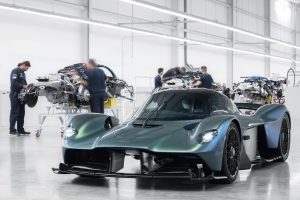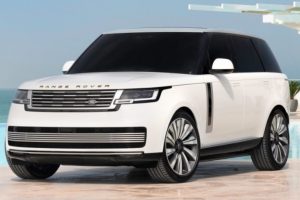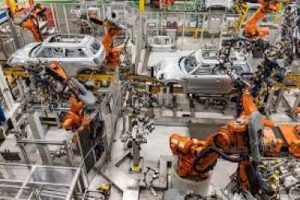Need for electric vehicle sparks green quest for commercial sector

IN the second part of his report on the greening of the commercial vehicle sector, Duncan Tift looks at how the Manufacturing Advisory Service is helping firms overcome the technological problems posed by the Low Carbon Programme and what the Government is doing to help the industry.
Finding a viable solution to the problem of cutting emissions and reducing the carbon footprint of the millions of cars on Britain’s roads has been difficult but the most successful option so far has proved to be the electric vehicle.
This is why virtually all major automotive manufacturers now have an EV somewhere within their product ranges.
Recognition of the importance of the technology has seen the Nissan Leaf crowned Word Car of the Year.
However, what of the commercial vehicle, where does its future lie.
The demise of Coventry based EV manufacturer has placed a big question mark over the viability of an electric van, truck bus or bulldozer.
A new roadmap laid down by the Automotive Council is seeking to redress this. The joint industry/government body is pushing a new strategy aimed at helping manufacturers of commercial vehicles and construction equipment move to low carbon solutions.
The strategy, the first to be published in Europe, outlines the drivers and timescales of technology development across the sector from delivery vans to bulldozers.
Technologies include hybridisation, more efficient powertrains and alternative fuels.
The roadmap is set to be a useful tool in determining research priorities as well as helping vehicle manufacturers and the supply chain draft long-term business plans.

Automotive Council co-chair Professor Richard Parry-Jones said: “The roadmap provides a strategic focus for the UK’s research and technology base to work in partnership with industry in these key sectors. As well as accelerating the pace of innovation and new product development, it will help ensure the UK maintains its position at the cutting edge of the low carbon automotive revolution.”
Heavy Goods Vehicles are claimed to contribute around 20% of overall domestic transport greenhouse gas emissions. Research conducted by the Department for Transport (DfT) has shown the most significant emissions savings from road freight will come from use of lower emission technologies such as hybrid and electric technologies and alternative fuels (biomethane and compressed natural gas).
However, there is a recognition that manufacturers cannot deliver the improvements on their own.
This is why bodies such as the Manufacturing Advisory Service are looking to intervene and support firms in the drive to develop the new technology.
MAS is currently inviting test centres and universities to promote their capabilities on a new searchable database of the UK’s public and privately owned testing facilities.
Working with the Government-backed Low Carbon Vehicles Partnership (LowCVP), UKTI, the Society for Motor Manufacturers and Traders (SMMT) and others, the site provides a resource for technology developers and manufacturers.
The site is focussed on low carbon vehicle technologies, materials, electronics, aerodynamics and other matters. The resource could also be expanded to become a central asset for UK technology companies and researchers.
In the West Midlands, MAS has worked with Halesowen based Bevan Group through the Low Carbon Programme to develop its new ICON vehicle body.
“Working with MAS-WM has been key in helping us to get this product to market,” said Bevan Group operations director Lee Dimmock.
“We’ve been working alongside a key supplier supported by Cranfield University on the concept design, tooling and CFD testing and MAS-WM have enabled us to establish that relationship and provide funding to make it happen.
“We are looking to develop new products at all times to make sure we stay ahead of the competition and our investment in design and technical expertise means the low carbon marketplace offers an excellent opportunity.”
He said the ICON was the latest example of this and had the potential to be a major part of the company’s continuing growth given that it not only offered fleets an impressive payload but it could also help them reduce fuel bills and their carbon footprint.
The vehicle is a crucial example of the way companies in the West Midlands are marrying technology with the needs of transport to try and produce a sustainable future.
“For our customers, the appearance of their vehicles is vital and the ICON has a fantastic on-road presence,” added Mr Dimmock.
Bevan is one of 3,000 companies in the West Midlands to have tapped into the in-depth support offered by MAS-WM to bring new products to market.
The support body, which is part funded by the European Regional Development Fund (ERDF), has a special focus on advanced manufacturing and low carbon initiatives.
Martin McKeever, a specialist manufacturing advisor at MAS-WM, said: “Taking a concept to the marketplace can require considerable investment and planning so it is encouraging to see Bevan adding another product to its portfolio.”
West Bromwich MP Adrian Bailey, who unveiled the ICON vehicle at the recent Commercial Vehicle Show, said: “It is fantastic that a Black Country company is at the cutting edge of commercial vehicle design with a prototype that saves fuel, lowers running costs and increases payload.
“At a time of high fuel prices this will help hard-pressed haulage companies and help reduce CO2 emissions.”
Anthony Bevan, managing director of Bevan Group, said: “The ICON represents a massive investment by Bevan and is the start of an exciting next phase in the company’s development.
“It is in line with our strategy of developing efficient, high payload and eye-catching vehicles for our client portfolio.”








